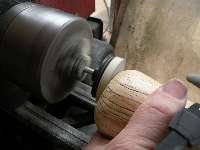Grahamshed
Established Member
When making the easter egg for the challenge ( The first thing I had turned ) I sanded down and applied two coats of cellulose sanding sealer then two coats of MC wax to all accessible parts while still on the lathe. I then parted off which left a tiny stub at the pointy end to be finished by hand. Duly sanded it was time for the sealer but it was inevitably going to go over the edges of the waxed finish as well.
Does it matter ?
How do you deal with that last little bit ?
Does it matter ?
How do you deal with that last little bit ?

































